Rondônia | |
|---|---|
| Estado de Rondônia State of Rondônia | |
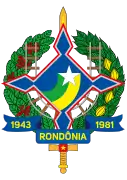 Coat of arms | |
| Anthem: Hino de Rondônia | |
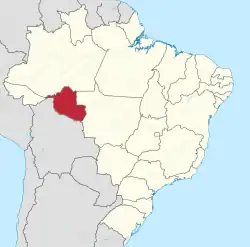 Location of State of Rondônia in Brazil | |
| Coordinates: 10°54′S 62°46′W / 10.90°S 62.76°W | |
| Country | |
| Founded | September 13, 1943 |
| Capital and largest city | Porto Velho |
| Government | |
| • Governor | Marcos Rocha (UNIÃO) |
| • Vice Governor | Sérgio Gonçalves (UNIÃO) |
| • Senators | Confúcio Moura (MDB) Jaime Bagattoli (PL) Marcos Rogério (PL) |
| Area | |
| • Total | 237,765 km2 (91,802 sq mi) |
| • Rank | 13th |
| Population (2023)[1] | |
| • Total | 1,581,016 |
| • Estimate (2023) | 1,581,016 |
| • Rank | 23rd |
| • Density | 6.6/km2 (17/sq mi) |
| • Rank | 19th |
| Demonym | Rondoniano(a) or Rondoniense |
| GDP | |
| • Year | 2006 estimate |
| • Total | US$ 11,287,000,000 (22nd) |
| • Per capita | US$ 6,327 (13th) |
| HDI | |
| • Year | 2021 |
| • Category | 0.700[2] – high (18th) |
| Time zone | UTC−4 (BRT–1[3]) |
| Postal Code | 76800-000 to 76999-000 |
| ISO 3166 code | BR-RO |
| License Plate Letter Sequence | NBB to NEH, OHL to OHW, OXL, QRA, QTA to QTJ, RSU to RSZ,NAH to NBA, , NUH to NUL, RZA to RZD |
| Website | rondonia.ro.gov.br |
Rondônia (Brazilian Portuguese: [ʁõˈdonjɐ] ⓘ) is one of the 26 states of Brazil, located in the northern subdivision of the country (central-western part). To the west is a short border with the state of Acre, to the north is the state of Amazonas, in the east is Mato Grosso, and in the south and southwest is Bolivia. Rondônia has a population of 1,815,000 as of 2021. It is the fifth least populated state. Its capital and largest city is Porto Velho, bathed by the Madeira River. The state was named after Cândido Rondon,[4] who explored the north of the country during the 1910s. The state, which is home to c. 0.7% of the Brazilian population, is responsible for c. 0.3% of the Brazilian GDP.
The state has 52 municipalities and occupies an area of 237,590.547 km², equivalent to the territory of Romania and almost five times larger than Croatia. In addition to this, there are other important cities such as Ariquemes, Cacoal, Guajará-Mirim, Ji-Paraná, Rolim de Moura and Vilhena.
Geography

Rondonia used to be home to over 200,000 km2 of rainforest, but has become one of the most deforested places in the Amazon. By 2003 around 70,000 km2 of rainforest had been cleared.[5]
The area around the Guaporé River is part of the Beni savanna ecoregion.[6]
The Samuel Dam is located in the state, on the Jamari River.[7]
History
Pre-colonial
Before the Portuguese discovery of Brazil, the region where the present state of Rondônia is situated was populated by indigenous peoples, who are known to have included the following:[8]
- pt:Aruás (Aruá language);
- Cinta Larga (language branch: Monde);
- Gavião (language branch: Monde);
- pt:Jabutis (language branch: Jaboti);
- Kanoê (language branch: Kanoê);
- Karipuna, Amondauas (language branch: Tupi-Guarani);
- Caritianas (language branch: Arikem);
- Araras-caros (language branch: Ramarama);
- Kaxarari (language branch: Pano);
- Kwazá (language branch: Kwazá);
- pt:Macurap, pt:Sakurabiat (language branch: Tupari);
- Nambikwara (language branch: Nambikwara);
- pt:Oro-uins (language branch: Txapakura);
- Paiter (language branch: Monde);
- Tuparis (language branch: Tupari)
Colonial Period
The Spaniard Ñuflo de Chávez was the first European explorer to reach the valley of the Guaporé River between 1541 and 1542, although he only passed through. Bandeirantes arrived in the region around 1650, with the goal of exploiting the gold and other minerals of the territory. In the same period, Jesuit priests came to the region and founded the first village.
.jpg.webp)
As a consequence of the discovery of gold on the right bank of the Guaporé River, the Portuguese Crown founded the Captaincy of Mato Grosso in 1748 with Antonio Rolim de Moura Tavares as governor.[9] On March 19, 1752, the governor designated Vila Bela da Santíssima Trindade as the capital,[10] from where he commanded the border demarcation following the Treaty of Madrid (1750). In 1753, he installed a surveillance post in the village of Santa Rosa Velha, built by the Spanish on the right bank of the Guaporé, and thus in Brazilian lands.[11] In 1759, the Spanish governor of Santa Cruz de la Sierra requested that the post be evacuated. Instead, Rolim de Moura built a fort to replace it, which became known as the Presídio de Nossa Senhora da Conceição. Due to the climate and the incursions of the Spanish, the Presidio was soon in ruins. It was rebuilt in 1769 by Governor Luís Pinto de Sousa Coutinho, and renamed as Forte de Bragança. Ruined again, in 1776 the Forte Príncipe da Beira was built in its place. In 1772, Francisco de Melo Palheta led an expedition from Belém which reached the Madeira River, the Mamoré River and the Guaporé River, reaching Santa Cruz de la Sierra.[12] The decline of mining and the proclamation of the First Brazilian Republic caused the region to lose its economic importance until the end of the nineteenth century, when the exploitation of rubber entered its peak.
Postcolonial history
In April 1878, following to the Treaty of Ayacucho, the border between Bolivia and Brazil was mapped by cartographic teams and agreed in 1879. The Treaty of Petrópolis in 1903 led to the construction of the Madeira-Mamoré Railroad, leading to increased settlement.[13]
Decree-Law No. 5812 (13 of September 1943) established the Federal Territory of Guaporé was created from parts of the states of Amazonas and Mato Grosso.[14] By the law of February 17 1956, the region became known as the Federal Territory of Rondônia, in honor of Marshal Cândido Rondon.[15] The exploitation of brazil nuts and rubber was the main economic activity until the discovery of cassiterite deposits, which accelerated the development and settlement of the region. This development led to the territory achieving the status of a state in 1982, with 13 constituent municipalities, including the capital, Porto Velho. These are: Guajará-Mirim, Ji-Paraná, Vilhena, Ariquemes, Jaru, Pimenta Bueno, Colorado do Oeste, Cacoal, Ouro Preto do Oeste, Presidente Médici, Espigão d'Oeste and Costa Marques.
Demographics
It is the third most populous state in the North Region with 1,815,278 inhabitants, according to an estimate by IBGE for 2021, being surpassed only by Pará and Amazonas. The population density was 6.6 inhabitants/km2. Urbanization: 66.8% (2004); Population growth: 2.2% (1991-2000); Houses: 430,747 (2005).[16] Four of its municipalities have a population above 100,000 inhabitants, these being Porto Velho, Ji-Paraná, Ariquemes and Vilhena.
The last PNAD (National Research for Sample of Domiciles) census revealed the following numbers: 832,000 Brown (Multiracial) people (54.81%), 546,000 White people (35.95%), 115,000 Black people (7.56%), 16,000 Asian people (1.08%), 8,000 Amerindian people (0.53%).[17]
The population of Rondônia is one of the most diverse in Brazil, composed of migrants from all regions of the country, among whom stand out the Paraná, São Paulo, Minas Gerais, and Rio Grande do Sul, who settled in the capital, still preserving the strong Amazonian traits of the native population in cities bathed by large rivers, especially in Porto Velho and Guajará-Mirim, the two oldest cities in the state.
Indigenous peoples
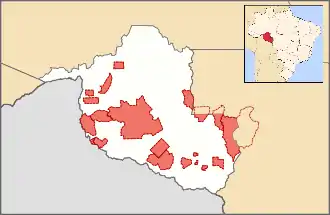
As of 2011 there were 21 Indigenous Territories in Rondônia, with two more in process of being demarcated.[18] The largest of these, the Uru-Eu-Wau-Wau Indigenous Territory, covers over 1.8 million hectares.[19] Another, the Rio Omerê Indigenous Territory, is home to the Kanoê and Akuntsu people. Both tribes were the victims of massacres by cattle ranchers in the 1970s and 1980s and currently number just four and five individuals respectively.[20][21]
Over 20 indigenous languages are spoken in Rondônia. Below is a list of indigenous languages spoken in the state:[22]
| Language | Family | Branch | ISO | Other names |
|---|---|---|---|---|
| Aikanã | language isolate | tba | Aikaná, Corumbiara, Huari, Kasupá, Kolumbiara, Masaká, Mundé, Tubarão, Uari, Wari | |
| Kanoé | language isolate | kxo | Canoé, Canoê, Guaratégaya, Guarategaja, Koaratira, Guaratira, Amniapé, Kapixaná, Kapixana, Kapishanã | |
| Kwaza | language isolate | xwa | Coaia, Koaiá, Koaya, Koayá, Quaiá, Arara | |
| Kaxararí | Panoan | ktx | Kasharari, Kaxariri | |
| Latundê | Nambikwaran | ltn | Leitodu | |
| Sabanês | Nambikwaran | sae | Sabané, Sabanê, Sabanés, Sabanes, Sabones, Sowainte | |
| Oro Win | Chapacuran | orw | dialects: Oro At, Oro Eo, Oro Mon, Oro Nao, Oro Waram, Oro Waram Xijem | |
| Arikapú | Macro-Jê | Jabutí | ark | Aricapú, Maxubí |
| Jabutí | Macro-Jê | Jabutí | jbt | Djeoromitxi, Dheoromitxí, Kipiu, Jabotí, Quipiu, Yabutí |
| Arikem | Tupian | Arikem | ait | Ariken, Arikém, Ariquême |
| Karitiâna | Tupian | Arikem | ktn | Caritiana, Karitiána, Karitiana |
| Aruá | Tupian | Mondé | arx | Aruaxi, Aruashí |
| Gavião do Jiparaná | Tupian | Mondé | gvo | Digüt, Gavião, Gavião do Rondônia, Ikõro |
| Suruí | Tupian | Mondé | sru | Paiter, Suruí de Rondônia, Suruí do Jiparaná, Suruí Paiter |
| Puruborá | Tupian | Puruborá | pur | Aurã, Boruborá, Burubora, Cujubi, Kuyubi, Miguelenho, Migueleno, Pumbora, Puroborá, Puruba |
| Karo | Tupian | Ramarama | arr | Arara, Arára, Arára de Rondonia, Arára do Jiparaná, Arara-Karo, Itanga, Itogapuc, Itogapúk, Ntogapid, Ntogapig, Ramarama, Uruku, Urukú |
| Akuntsu | Tupian | Tuparí | aqz | |
| Makuráp | Tupian | Tuparí | mpu | Macuráp, Macurape, Macurapi, Makurápi, Massaka |
| Tuparí | Tupian | Tuparí | tpr | |
| Wayoró | Tupian | Tuparí | wyr | Ajurú, Ayurú, Uaiora, Wajaru, Wayru, Wayurú |
| Amundava | Tupian | Kawahiva | adw | Amondawa, Amondáwa, Amundawa, Amundáwa |
| Uru-Eu-Wau-Wau | Tupian | Kawahiva | urz | Eru-Eu-Wau-Wau, Kagwahiva, Uru-Eu-Uau-Uau, Uruewawau, Urueuwawáu |
| Warázu[23] | Tupian | Guarayu | psm | Pauserna |
| Conjubim | Chapacuran |
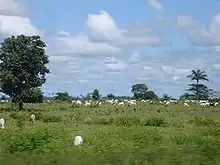
Economy


The economy of the state of Rondônia has, as main activities, agriculture, livestock, food industry and vegetal and mineral extraction. In 2016, the state's GDP reached R$ 39.451 billion. Its export basket is mainly composed of frozen beef (43.43%), soy (32.77%), raw tin (7.08%), sawn wood (2.36%) and edible giblets (2.02%).[24][25]
Beginning in the 1970s, the state attracted farmers from the south-central part of the country, stimulated by the federal government's colonization projects and the availability of cheap and fertile land. The development of agricultural activities has transformed the area into one of the main agricultural frontiers in the country and one of the most prosperous and productive regions in northern Brazil. The state stands out in the production of coffee (largest producer in the North and 5th largest in Brazil), cocoa (2nd largest producer in the North and 3rd largest in Brazil), beans (2nd largest producer in the North), maize (2nd largest producer in the North region), soybean (3rd largest producer in the North region), rice (3rd largest producer in the North region) and cassava (4th largest producer in the North region). Despite the large volume of production and the small territory by the region's standards (7 times smaller than Amazonas and 6 times smaller than Pará), Rondônia still has more than 60% of its territory fully preserved.
In coffee production, Rondônia was, in 2019, the 5th largest producer in the country, being the 2nd largest producer of Coffea canephora, getting a total of 2.3 million bags of 60 kg of coffee (near 138 thousand tons) this year.[26]
In soy, in the 2019 Brazilian harvest, Rondônia harvested 1.2 million tons, 3rd in the North Region.[27][28][29]
In 2019, the state produced 805 thousand tons of maize, second largest production in the northern region, losing only to Tocantins.[30]
In cassava production, Brazil produced a total of 17.6 million tons in 2018. Rondônia was the 11th largest producer in the country, with 583 thousand tons.[31]
In 2018, Rondônia produced 124 thousand tons of rice.[32]
In the production of cocoa, Pará has been competing with Bahia for the leadership of Brazilian production. In 2019, Pará harvested 135 thousand tons of cocoa, and Bahians harvested 130 thousand tons. Rondônia is the 3rd largest cocoa producer in the country, with 18 thousand tons harvested in 2017.[33][34]
In 2017, the state had a cattle herd of 14,098,031 head of cattle (73,37% for beef and the rest for dairy), second largest herd in the North, second only to Pará, being the 6th largest in the country, 5th in meat exports and 8th in milk production.[35] The state's milk production in 2018 was around 800 million liters, the largest producer in the North.[36]
In 2017, Rondônia had 0.62% of the national mineral participation (8th place in the country). Rondônia had production of tin (10,9 thousand tons at a value of R$ 333 million), gold (1 ton at a value of R$ 125 million), niobium (in the form of columbita-tantalita) (3.5 thousand tons at R$ 24 million), and zinc in gross form (26 thousand tons at R$ 27 million)[37] In addition, in gemstones, the state has some production of garnet.[38]
In industry, Rondônia had an industrial GDP of R$ 8.2 billion in 2017, equivalent to 0.7% of the national industry. It employs 49,944 workers in the industry. The main industrial sectors are: Industrial Services of Public Utility, such as Electricity and Water (54.4%), Construction (19.2%), Food (17.6%), Wood (1.8%) and Non-metallic minerals (1.2%). These 5 sectors concentrate 94.2% of the state's industry.[39]
Transport
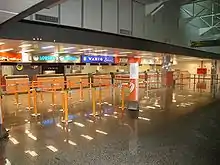
Governador Jorge Teixeira de Oliveira International Airport is located in the state capital of Porto Velho.[40]
The state of Rondônia has 24,000 kilometers of highways, of which only 7% are paved. The BR-364, fully paved in the Rondônia section, crosses the state from the border with Mato Grosso to the border with Acre. It is the main route for the outflow of grain production (especially soy) from the south of Rondônia and the west of Mato Grosso to the city of Porto Velho, where the grain port is located. A bridge is being built over the Madeira River (the first over this river), which aims to consolidate road transport between Brazil and Peru.[41]
Education
The quality of Education in Rondônia is considered the fourteenth best in the country, compared to other Brazilian states. In the list of Brazilian states by HDI, with data from 2010, the “Education” factor reached an index of 0.557, an increase of more than 67% compared to 2000, when the state reached only 0.345.
According to the Brazilian Institute of Geography and Statistics (IBGE), in 2021 there were 244,815 enrollments in primary education in Rondônia.[42]
See also
References
- 1 2 "Rondônia | Cidades e Estados | IBGE". www.ibge.gov.br. Retrieved 2022-12-27.
- ↑ "Atlas do Desenvolvimento Humano no Brasil. Pnud Brasil, Ipea e FJP, 2022". www.atlasbrasil.org.br. Retrieved 2023-06-11.
- ↑ "Flag Current Local Time in Porto Velho, Rondônia, Brazil". Time and Date. Retrieved 15 August 2016.
- ↑ Revkin, Andrew (2004-09-30). The Burning Season: The Murder of Chico Mendes and the Fight for the Amazon Rain Forest. Island Press. p. 118. ISBN 9781610913485.
- ↑ "Amazon Deforestation". Earth Observatory. NASA. 2009-05-27. Retrieved 7 October 2012.
- ↑ Robin Sears and Robert Langstroth. "Central South America: Northern Bolivia". Tropical and Subtropical Grasslands, Savannas and Shrublands. WWF. Retrieved 7 October 2012.
- ↑ "Samuel Dam, Rondônia, Brazil". U.S. Geological Survey. 13 October 2011. Retrieved 26 January 2015.
- ↑ "Povos Indígenas no Brasil". pib.socioambiental.org. Instituto Socioambiental. Retrieved 13 April 2019.
- ↑ Antonio Torres Montenegro (2008). História, cultura e sentimento: outras histórias do Brasil. Editora Universitária UFPE. pp. 174–. ISBN 978-85-7315-528-0.
- ↑ David Price: Pareci, Cabixi, Nambiquara. A case study in the western classification of native peoples. In: Journal de la Société des Américanistes vol.69, 1983, pp.129-148, doi : 10.3406/jsa.1983.2228 (online)
- ↑ Marcelo Vianna; Cristiano Enrique de Brum; Débora Soares Karpowicz. O historiador e as novas tecnologias - reunião de artigos do II Encontro de Pesquisas Históricas - PUCRS: Evento acadêmico - História - Encontro - Pós-graduação - Graduação – PUCRS. Memorial do Ministério Público do Rio Grande do Sul. pp. 1989–. ISBN 978-85-88802-22-3.
- ↑ Pontes Pinto, Emanuel. "VIAGEM DE DESCOBRIMENTO AO RIO MADEIRA E SUAS VERTENTES POR FRANCISCO DE MELO PALHETA". periódicos.unir.br. Universidade Federal de Rondônia. Retrieved 13 April 2019.
- ↑ Lome, Herbert M. (1910). An American Sanitary Triumph in Brazil. New York: Doubleday, Page & Co. Retrieved 13 April 2019.
- ↑ "DECRETO-LEI Nº 5.812, DE 13 DE SETEMBRO DE 1943". planalto.gov.br. Government of Brazil. Retrieved 13 April 2019.
- ↑ Oliver Marshall; David Cleary; Dilwyn Jenkins (2009). The Rough Guide to Brazil. Rough Guides Limited. pp. 437–. ISBN 978-1-84836-189-8.
- ↑ Source: PNAD.
- ↑ Tabela 262: População residente, por cor ou raça, situação e sexo (PDF) (in Portuguese). Rondônia, Brazil: IBGE. 2008. ISBN 978-85-240-3919-5. Retrieved 2010-01-18.
- ↑ "Terras Indígenas: Pesquisa por Estado: Rondônia". Povos Indígenas no Brasil (in Portuguese). Instituto Socioambiental (ISA). Retrieved 24 March 2011.
- ↑ "Caracterização Terra Indígena Uru-Eu-Wau-Wau". Povos Indígenas no Brasil (in Portuguese). Instituo Socioambiental (ISA). Retrieved 24 March 2011.
- ↑ Instituto Socioambiental (ISA). "Introduction > Akuntsu". Povos Indígenas no Brasil. Retrieved 8 March 2011.
- ↑ Instituto Socioambiental (ISA). "Introduction > Kanoê". Povos Indígenas no Brasil. Retrieved 8 March 2011.
- ↑ Cronhamn, Sandra (2013). The spread of cultural vocabulary in Rondônia: A study of borrowability in the semantic fields of religion and agriculture. B.A. thesis. Lund University.
- ↑ Ramirez, Henri; Vegini, Valdir; França, Maria Cristina Victorino de (2017). "O warázu do Guaporé (tupi-guarani): Primeira descrição linguística" [Warázu of Guaporé (Tupi-Guarani): first linguistic description]. LIAMES (in Portuguese). 17 (2): 411–506. doi:10.20396/liames.v17i0.8647468.
- ↑ Roraima PIB
- ↑ Rondonia Exports
- ↑ Produção de café conilon avança e pode ter safra recorde em 2019 gerando emprego e renda
- ↑ Rondônia deve produzir 1,2 milhão de toneladas de soja na safra 2019/2020
- ↑ Soja é ouro no estado do Tocantins
- ↑ Especialistas e produtores debatem sobre a expansão da soja no Pará
- ↑ Colheita do milho safrinha cresce 20% e Conab estima produção de 805 mil toneladas em Rondônia
- ↑ Produção brasileira de mandioca em 2018
- ↑ Safra de arroz tem aumento de produtividade em Rondônia
- ↑ Pará retoma liderança na produção brasileira de cacau, com a união de agricultores
- ↑ Rondônia é o terceiro maior produtor de cacau do Brasil
- ↑ Rebanho bovino ultrapassa 14 milhões de cabeças em Rondônia
- ↑ Produção de leite em Rondônia resulta em cerca de 800 milhões de litros por ano e é um dos destaques da feira
- ↑ Anuário Mineral Brasileiro 2018
- ↑ Algumas Gemas Clássicas
- ↑ Industry Profile of Rondonia
- ↑ "Porto Velho, Belmonte (PVH) information". theAirDB. Retrieved 1 January 2013.
- ↑ "Ficha del Proyecto". www.iirsa.org. Retrieved 2023-05-17.
- ↑ "Rondônia | Cities and States | IBGE". www.ibge.gov.br. Retrieved 2023-05-17.
External links
- (in Portuguese) Official Website


